|
|
|
| Sedimentary cycle division using peak frequency of time-frequency Teager-Kaiser energy |
| HE Wen1, CAI Jia-Ming1, SONG Zhi-Hua2, LI Hai-Yin1, ZHANG Hao1, HUANG Kong-Zhi1, GUAN Yan-Bin1 |
1. Geophysical Research Institute of BGP,CNPC, Zhuozhou 072751,China
2. Exploration Department,Xinjiang Oilfield Company,PetroChina,Karamay 834000,China |
|
|
|
|
Abstract Sedimentary cycle analysis plays an important role in stratigraphic theory research and petroleum exploration and development.Qualitative division of logging curves is a conventional method for dividing sedimentary cycles,which is more accurate at wellbore locations,but the division of sedimentary cycles in non-wellbore locations mainly depends on geological knowledge and has strong subjectivity.Seismic data contain abundant information related to sedimentary cycles.Sedimentary cycles can be divided by using time-frequency attribute curves.In this paper,the generalized S-transform method with better time-frequency resolution is used to calculate the time-frequency attribute curve,and the method is applied to four sedimentary cycle models:normal cycle,inverse cycle,normal-inverse cycle and inverse-normal cycle.The results of cycles division of the model validate the validity of the peak frequency attributes of time-frequency spectrum in the division of sedimentary cycles;However,in the practical application of seismic data,the time resolution of time-frequency spectrum is not high.Teager-Kaiser energy spectrum based on time-frequency spectrum improves the time positioning and focusing of time-frequency analysis results.The division of sedimentary cycles based on Teager-Kaiser energy spectrum attributes can better depict the changes of geological structure and thin interbedded structure.The method is applied to the Jurassic sedimentary cycle division of an oil field in Xinjiang.The results of the division are in good agreement with those of the well data,which verifies the reliability of the method.
|
|
Received: 30 September 2019
Published: 29 December 2020
|
|
|
|
|
|

|
Normal cycle model and its seismic response
a—velocity model;b—reflection coefficient;c—synthetic;d—time-frequency spectrum
|
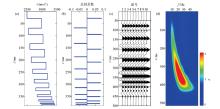
|
Inverse cycle model and its seismic response
a—velocity model;b—reflection coefficient;c—synthetic;d—time-frequency spectrum
|
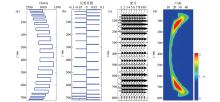
|
Inverse-normal cycle model and its seismic response
a—velocity model;b—reflection coefficient;c—synthetic;d—time-frequency spectrum
|
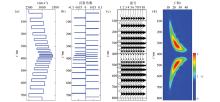
|
Normal-inverse cycle model and its seismic response
a—velocity model;b—reflection coefficient;c—synthetic;d—time-frequency spectrum
|
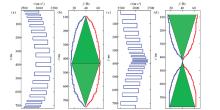
|
Inverse-normal cycle model and its peak frequency mirror image、normal-inverse cycle model and its peak frequency mirror image
a—inverse-normal cycle model;b—peak frequency mirror image of model a;c—normal-inverse cycle model;d—peak frequency mirror image of model c
|
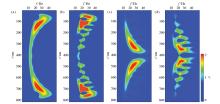
|
TK energy spectrum test of cycle model
|
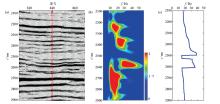
|
Seismic profile、seismic trace time-frequency spectrum cross well and peak frequency curve
a—seismic profile;b—seismic trace time-frequency spectrum cross well;c—peak frequency curve cross well
|
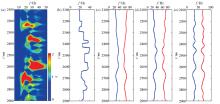
|
T-K energy spectrum、T-K peak frequency curve and its frequency-division curve
a—T-K energy spectrum;b—T-K peak frequency curve;c—low frequency component of b;d—intermediate frequency component of b;e—high frequency component of b
|
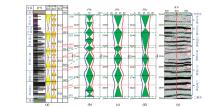
|
Cross-well section interpretation results based on time depth calibration and previous results
a—geological stratification,lithology and cycle based on lithology division;b—short-term cycle;c—medium-term cycle;d—long-term cycle;e—seismic profile
|
| [1] |
张贤达, 保铮. 非平稳信号分析与处理[M]. 北京: 国防工业出版社, 1998.
|
| [1] |
Zhang X D, Bao Z. Nonstationary signal analysis and processing[M]. Beijing: National Defense Industry Press, 1998.
|
| [2] |
刘葵, 刘招军, 朱建伟, 等. 时频分析技术在石油地球物理勘探中的应用[J]. 世界地质, 2000,19(3):282-284.
|
| [2] |
Liu K, Liu Z J, Zhu J W, et al. Application of time-frequency analysis in geology[J]. Global Geology, 2000,19(3):282-284.
|
| [3] |
杨培杰, 印兴耀, 张广智. 希尔伯特—黄变换地震信号时频分析与属性提取[J]. 地球物理学进展, 2007,22(5):1595-1590.
|
| [3] |
Yang P J, Yin X Y, Zhang G Z. Seismic signal time-frequency analysis and attributes extract based on HHT[J]. Progress in Geophysics, 2007,22(5):1595-1590.
|
| [4] |
Stockwell R G, Mansinha L, Lowe R P. Localization of the complex spectrum:the S transform[J]. IEEE Transactions on Signal Processing, 1996,44(4):998-1001.
|
| [5] |
陈学华, 贺振华, 黄德济. 基于广义S变换的地震资料高效时频谱分解[J]. 石油地球物理勘探, 2008,43(5):530-534.
|
| [5] |
Chen X H, He Z H, Huang D J. High efficient time-frequency spectrum decomposition of seismic data based on generalized S transform[J]. OGP, 2008,43(5):530-534.
|
| [6] |
Teager H, Teager S. Evidence for nonlinear production mechanisms in the vocal tract[J]. Speech Production & Speech Modeling, 1990,55:241-261.
|
| [7] |
Kaiser J F. On a simple algorithm to calculate the 'energy' of a signal[J]. IEEE ICASSP, 1990: 381-384.
|
| [8] |
Jabloun F, Cetin A E, Erzin E. Teager energy based feature parameters for speech recognition in car noise[J]. IEEE Signal Processing Letters, 1999,6(10):258-261.
|
| [9] |
Nehe N S, Holamber R S. Power spectrum difference teager energy features for speech recognition in noisy environment[C]// IEEE Region 10 Colloquium and the Third International Conference on Industrial and Information Systems, 2008: 1-5.
|
| [10] |
Matos D, Marfurt K J. Wavelet transform Teager-Kaiser energy applied to a carbonate field in Brazil[J]. The Leading Edge, 2009,28(6):708-713.
|
| [11] |
刘振峰, 郝天珧, 范国章. 沉积旋回的地球物理研究[J]. 石油实验地质, 2004,26(3):258-262
|
| [11] |
Liu Z F, Hao T Y, Fan G Z. Geophysical study of sedimentary cycles[J]. Petroleum Geology & Experiment, 2004,26(3):258-262.
|
| [12] |
高永进. 砂砾岩体沉积旋回划分方法及对比方法——以济阳坳陷盐家地区沙四段上亚段为例[J]. 油气地质与采收率, 2010,17(6):6-11.
|
| [12] |
Gao Y J. Sedimentary cycle division and correlation of sand-conglomerate body in upper Sha IV Formation of Yanjia area, Jiyang depression[J]. Petroleum Geology and Recovery Efficiency, 2010,17(6):6-11.
|
| [13] |
徐敬领, 王贵文, 刘洛夫. 利用小波深频分析方法研究地层沉积旋回[J]. 中国石油大学学报:自然科学版, 2009,33(5):1-5
|
| [13] |
Xu J L, Wang G W, Liu L F. Study of sedimentary reservoir cycles using wavelet depth-frequency analysis method[J]. Journal of China University of Petroleum:Edition of Nature Science, 2009,33(5):1-5.
|
| [14] |
黄捍东, 冯娜, 王彦超, 等. 广义S变换地震高分辨率处理方法研究[J]. 石油地球物理勘探, 2014,49(1):82-88.
|
| [14] |
Huang H D, Feng N, Wang Y C, et al. High-resolution seismic processing based on generalized S transform[J]. OGP, 2014,49(1):82-88.
|
| [15] |
徐敬领, 王贵文, 刘洛夫, 等. 应用Hilbert-Huang变换方法研究等时小层划分及对比[J]. 石油地球物理勘探, 2010,45(3):423-430.
|
| [15] |
Xu J L, Wang G W, Liu L F, et al. Application of Hilbert-Huang transform to study classification and correlation of isochrones substratum[J]. OGP, 2010,45(3):423-430.
|
| [16] |
邹才能, 张颖. 油气勘探开发实用地震新技术[M]. 北京: 石油工业出版社, 2002.
|
| [16] |
Zou C N, Zhang Y. New seismic techniques of exploration and development of oil and gas [M]. Beijing: Petroleum Industry Press, 2002.
|
| [17] |
Liu Y L, Yang G Q, Cao W J. The division of sedimentary cycle based on HHT[C]// SEG Technical Program Expanded Abstracts, 2015: 1902-1906.
|
| [18] |
葸晓宇, 刘洪. HHT方法在研究地震旋回体中的应用[J]. 吉林大学学报:地球科学版, 2007,37(3):624-628.
|
| [18] |
Xi X Y, Liu H. The application of HHT method in study of seismic cycle[J]. Journal of Jilin University:Earth Science Edition, 2007,37(3):624-628.
|
| [1] |
HUANG Wei, ZHOU Jie, GAO Li-Jun, WANG Sheng-Li, YAN Hai-Tao. The application of frequency division ant tracking based on synchronous extrusion improvement of short time Fourier transform in crack detection[J]. Geophysical and Geochemical Exploration, 2021, 45(2): 432-439. |
| [2] |
NIE Wei-Dong, LI Xue-Ying, WAN Qiao-Sheng, WANG Fu-Lin, HE Xu-Chao. A time-frequency feature analysis of cyclic thin interbeds based on time-frequency analysis of affine class[J]. Geophysical and Geochemical Exploration, 2020, 44(4): 763-769. |
|
|
|
|
